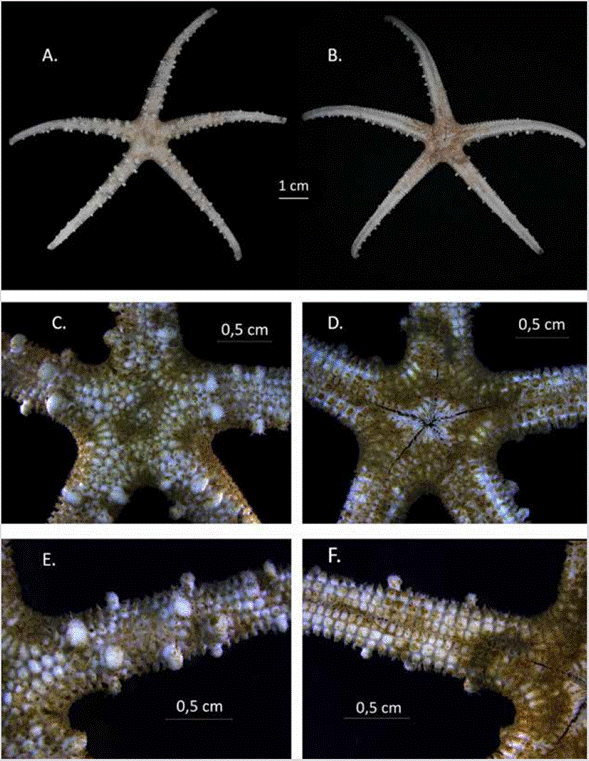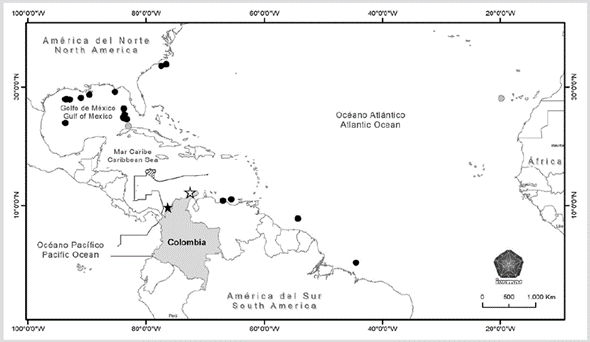Chaetasteridae is a family of the class Asteroidea (phylum Echinodermata) that includes only two species for the Atlantic Ocean, both belonging to the genus Chaetaster, which are Chaetaster nodosus Perrier, 1875 and Chaetaster longipes (Bruzelius, 1805) in the eastern Atlantic (Clark and Downey, 1992). This class, which includes the animals commonly known as starfishes, is one of the most abundant and diverse taxa in the phylum Echinodermata (Pawson, 2007). In Colombia, the knowledge about this group had been increasing. According to Alvarado (2011) and Pérez-Rufaza et al. (2013), Colombia is one of the Latin-American countries with the largest number of asteroids species. Álvarez (1981) presented an initial list of echinoderms for the Colombian Caribbean, where he cited eleven asteroids species. Subsequently, Benavides-Serrato et al. (2005) presented a taxonomic list of the asteroids of the continental shelf and the upper slope of the Colombian Caribbean, in which they cited 35 species. Finally, the most actualized and complete paper (Benavides-Serrato et al., 2011) mentioned 67 species of asteroids for the Colombian Caribbean.
One specimen of Chaetaster nodosus was collected in Coralline Archipelagos, in front of San Bernardo islands. Coralline Archipelagos is one of the ecoregions defined for the Colombian Caribbean that is encompassed by islands, shallow carbonate platforms, and coral shoals located off the mainland coast between Islas del Rosario and Isla Fuerte, as well as the continental shelf between 40 and 130 m depth. This clear water ecoregion has a high diversity of species, as well as habitats with coral reefs, bioclastics sand flats, seagrass beds and mangroves in some islands (Díaz and Acero, 2003).
The collected specimen was separated and preserved in 70 % ethanol, photographed and identified using the taxonomic keys presented by Downey (1973) y Clark y Downey (1992). The specimen was deposited in the echinoderm collection of the Marine Natural History Museum of Colombia (MHNMC) Makuriwa of the Marine and Coastal Research Institute (Invemar).
Class Asteroidea
Family Chaetasteridae Sladen, 1889
Genus Chaetaster Müller y Troschel, 1840 Chaetaster nodosus Perrier, 1875
Identification references: Downey (1973: 65. Pl. 24 C, D), Clark and Downey (1992: 144, 146. Pl. 35 C, D).
Material examined: 1 specimen INV EQU4789, R: 50 mm, r: 7 mm, R/r: 7.1/1, E 327 B (9°37'04" N-76°16'41" W), 98 m depth.
Description: Disc small with five long, slender, rounded arms, tapering to acute point (Figure 1A). Well-spaced abactinal plates in regular rows; one carinal row and four or five dorsolaterals on each side; only one row continuing all the way to the terminal plate; plates more or less equal in size, somewhat irregular in shape (Figure 1C). Abactinal plates subpaxillate, with broad flat top densely covered with small granule-like tubercles bearing hyaline spinelets; a few scattered plates on the arms larger, raised above the general surface, being distinctly nodose (Figure 1E); paxillae nearly touching, concealing the base of plates. Large single papulae between plates. Two series of large rectangular marginals plates mostly confined to lower surface, armed like abactinal plates, proximal ones much broader than long. Actinal plates few, confined to disc. Adambulacral plates bearing 6-7 very short, stubby furrow spines parallel to groove, and a subpaxillate patch of subambulacral spinelets similar to those of abactinal and marginals. Mouth plates small, narrow, densely covered with long sharp spines (Figure 1D). Madreporite small, flat, and deeply channeled. Terminal plate large, bare and round (Downey, 1973; Clark and Downey, 1992).

Figure 1 Chaetaster nodosus. A) General abactinal view. B) General actinal view. C) Disc detail in abactinal view. D) Disc detail in actinal view showing the jaw. E) Arm detail in abactinal view. Nodoses plates raised above the general surface observed. F) Arm detail in actinal view. Ambulacral groove and the adambulacral plates observed.
Distribution: Chaetaster nodosus is distributed in the eastern Atlantic in the Canary Islands (Pérez-Ruzafa et al., 2013) and in the western Atlantic from Bermuda and North Carolina (USA), including the Gulf of Mexico and the Caribbean (Cuba, Venezuela, Suriname and Colombia) to Brazil (4° S) (Clark and Downey, 1992; GBIF.org, 2019; Orrel, 2019) (Figure 2). This paper reports the species for the first time in Colombia, based on one specimen collected in the ICP project. In addition, one individual deposited in the National Museum of Natural History from the Smithsonian (NMNH-Smithsonian), catalog number USNM 1226493, is included. This individual was collected in 1965 by the United States Fish and Life Service, northwest of the Guajira peninsula at 207 m depth by the R/V Oregon. This depth would expand the bathymetric range of the species cited by Clark and Downey (1992) which is 53 to 207 m.

Figure 2 Known geographical distribution of the Chaetaster nodosus species. It indicates the location of the specimen collected in the ICP project (black star) and that of the specimen USNM 1226493 from Colombian (white star); the records of the species included in the GBIF and NMNH-Smithsonian databases (black dots), and those of Alvarado and Solís-Marín (2013), which do not correspond to exact coordinates (gray dots).
Comments: Although currently Chaetasteridae is recognized as a family, Downey (1973) considered the genus Chaetaster a highly specialized ophidiasterid, synonymizing Chaetasteridae family and restoring this genus to the family Ophidiasteridae, from which it had been previously removed. Chaetasteridae has also been placed in or near Echinasteridae and Asterinidae. On the other hand, Tommasi (1971) described Chaetaster vanzolinicus as a species different from C. nodosus, because of the greater number of rows of abactinal plates (dorsal and lateral) on the arms. However, this species was not accepted, because the number of rows of plates does not seem to be much higher. Also, the additional rows that could be present were explained by the larger size of the specimen respects to the average, since the number of rows and the size of the plates in many starfish increase with growth (Clark, 1922; Clark and Downey, 1992). The specimen collected could be a juvenile considering the size reported by Clark and Downey (1992) of R = 90 mm and R/r = 8.2/1.











 texto en
texto en 


